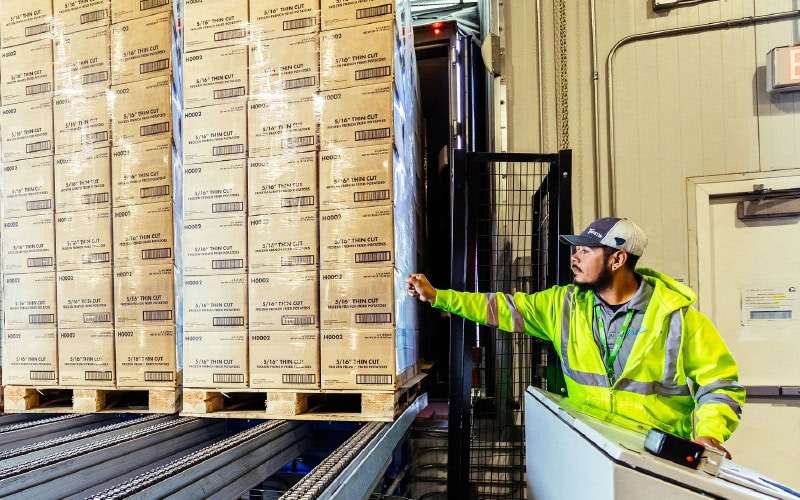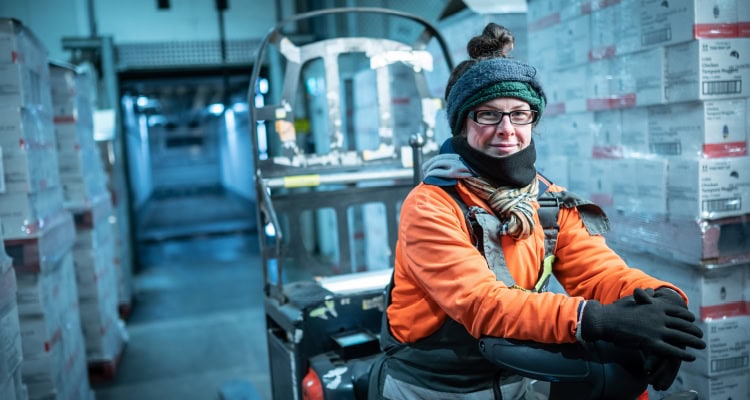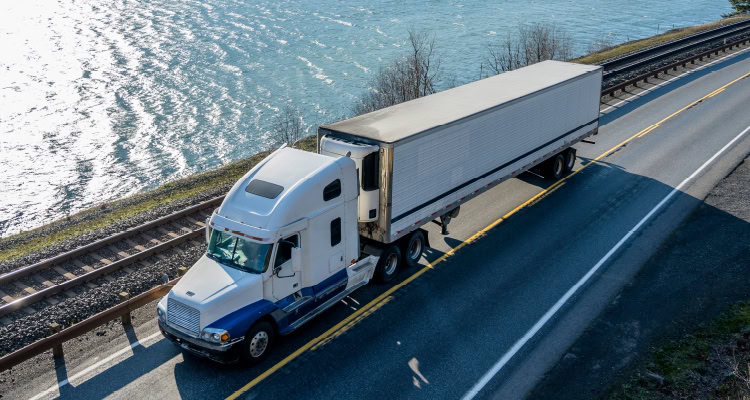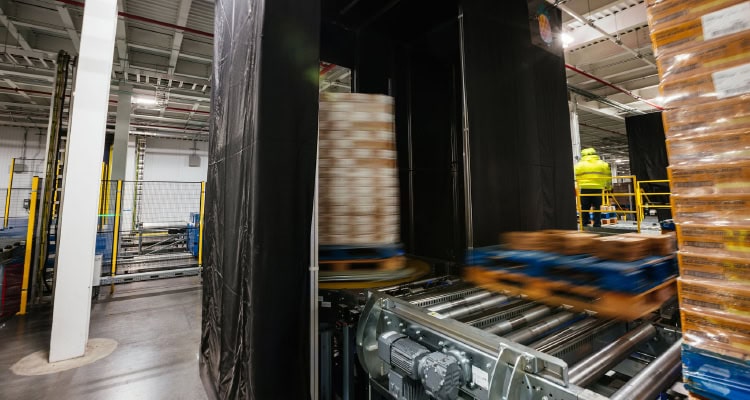Keep It Cool: Rolling Out High-Velocity Cold Chain Solutions

Increasingly dynamic and strategic, the global cold chain demands higher degrees of precision. Here are partners who can tackle complexity, ensure compliance, and deliver with speed and accuracy.
Each day, thousands of temperature-controlled shipments, from fresh produce to vaccines, crisscross the globe in an intricate web of highly specialized infrastructure and technology.
More than $2.7 trillion worth of temperature-controlled goods were shipped by truck in 2022, the most recent year for which figures are available from the U.S. Census Bureau, representing 90% of the temperature-controlled goods shipped by all modes.
Cold chain and temperature-controlled shipping continues to gain visibility as demand for pharmaceutical and healthcare products remains strong, and the global expansion of food and beverage supply chains requires compliance with regulations to ensure product safety and quality.
Navigating a Dynamic Market
“Globalization, urbanization, and consumer demand for convenient, fresh, high-quality food options has opened up new growth opportunities for food growers and producers,” says Sudarsan Thattai, chief information officer and chief transformation officer for Lineage. “To be able to serve these customers, food companies will need robust networks of temperature-controlled warehousing and reliable transportation solutions to move those products safely and efficiently.”
The cold chain market has shifted from static storage to high-velocity, integrated logistics solutions. Customers are looking for partners who can help them navigate global complexity, ensure compliance, and deliver with speed and precision.
“That’s why Americold has invested in import-export hubs—not just facilities—at key ports and rail corridors. These hubs are designed to streamline cross-border flows and reduce dwell time, especially for high-volume, high-value products,” says Rob Chambers, CEO of Americold.
One of the most significant shifts has been the move toward technology-enabled cold chain logistics, from real-time monitoring and automation to predictive analytics.
“Capturing and reporting data in this manner increases accountability, reduces risk, decreases exposure to liability, and reduces labor and paperwork required to capture this data as compared to prior models. And all of this can be accomplished through technology and equipment available in the marketplace today,” says Jeff Lyskoski, executive vice president sales and marketing, Honolulu Freight Service.
Real-time monitoring provides continuous visibility for chain-of-custody and control verification, passive tracking, reverse logistics, and loss prevention, regardless of transportation mode.
“Consumers want to shop confidently and know more about the food they’re eating—whether that’s to reach nutritional goals or prevent foodborne illness—and companies who provide transparency are better positioned to win over shoppers,” Thattai says.
As the threat of cargo loss increases, cold chain shipments are often a prime target. Maintaining chain of custody is critical at each stop along the way. Carriers utilize advanced technology and operational policies to mitigate risks. For instance, artificial intelligence (AI) and computer vision tools help identify and validate trucks and trailers, exposing fraud schemes to thwart thefts and enable product recovery.
Some refrigerated carriers instruct drivers not to stop within 200-300 miles of a pickup point to deter thieves from following a high-value load. Geofencing establishes virtual boundaries that define where drivers are permitted to travel. The system can send alerts if a truck is driven outside the designated area to identify possible cargo loss.
Carrier vetting is a critical element to ensuring product safety. Logistics providers research carrier backgrounds to verify that drivers meet licensing and other regulations and make sure systems are equipped with telematics, ELD, and geofencing tech to ensure security, visibility, and compliance.
Transformational Technology
Improved technology has reshaped the flow of products internationally, opening up new sources of fresh produce for U.S. markets. This market expansion is built on complete end-to-end reefer monitoring and asset management at every hand-off point. The cold chain extends across continents, regulatory systems, and transport modes, making it more complex and more interconnected.
“Requirements necessary to maintain consistently controlled temperatures, and to provide evidence of these practices on a case-by-case basis, represent the ongoing challenges of cold chain supply,” says Lyskoski. “Service providers and cargo owners alike are being challenged to move products farther and faster every day.”
For example, imported fruit flowing into ports in Southern New Jersey, Philadelphia, and Delaware used to have a distinct seasonality.
“Now imported fruit into this market happens year-round,” says Joe Kouten, former vice president of sales at Genpro. “This means the requirements of the domestic cold chain must now be extended to countries of origin and require additional inspection upon arrival in the United States. The same temperature monitoring requirements of domestic shipments apply to international shipments as well.”
Advanced technologies, such as AI and machine learning, are playing a bigger role for cold chain logistics providers, allowing them to offload repetitive work and enable employees to focus on strategic relationships.
Logistics providers are automating formerly manual tasks such as load acceptance, order entry, pricing, assigning trucks to loads, contacting carriers when exceptions are identified, sorting and warehousing documents, and reporting.
“Although technology boasts many wonderful things, the tools are only as efficient as the teams using them,” Lyskoski says. “Service providers must manage their processes using efficient and effective tools to control operating costs and determine how to provide these critical services to their customers at affordable rates.”
Here’s a look at some of the top temperature-controlled logistics providers with the people, processes, infrastructure, and technology to support real-time visibility, cargo security, and regulatory compliance.
Americold: Technology-Enabled Cold Chain Logistics

Combining high touch with high tech, Americold ensures product integrity with AI-enabled tracking, predictive analytics, and real-time monitoring.
Customer expectations for cold chain shipments have intensified dramatically. Today’s consumers and food brands demand real-time visibility, uncompromising safety, and full transparency, because reputations, businesses, and in many cases, lives are on the line when it comes to food safety.
“This isn’t just about logistics. It’s about trust,” says Rob Chambers, Americold CEO. “The industry is responding with more advanced tools, and Americold is going further by combining high tech with high touch.”
Americold is investing in AI-enabled tracking, predictive analytics, and real-time monitoring to ensure product integrity. The company deploys real-time monitoring of temperature and energy usage across more than 90% of its facilities, enabling precise control and rapid response. Automated storage and retrieval systems reduce handling errors and maintain consistent product conditions.
The company is especially focused on predictive analytics, robotics, and innovations in refrigeration and packaging.
But the biggest shift may be structural: the move toward hub-based, multimodal networks that integrate storage, transport, and compliance in a single ecosystem.
“This shift is essential because it enables the cold chain to be not only faster and more efficient, but also more resilient, traceable, and responsive to global customer demands,” Chambers says.
Americold has kept pace with globalization by building a network of 239 facilities in 12 countries to orchestrate movement across continents, regulatory systems, and transport modes.
To succeed in this environment, companies must go beyond infrastructure and invest in strategic partnerships that enable seamless, multimodal food flow.
Americold has embraced this model by building networks of trust and capability across the global cold chain.
“Our joint venture with RSA Global in the Middle East, and our partnerships with DP World and CPKC, are designed to integrate cold storage with port and rail infrastructure,” says Mathew Moore, vice president, global market strategy for Americold. “These relationships allow us to deliver faster, more resilient, and more compliant solutions for our customers—especially those navigating cross-border trade and high-value perishables.”
Employing a Multi-Faceted Strategy
As cold chains extend around the world, the refrigerated shipping industry faces several pressing sustainability challenges, including high energy consumption, refrigerant emissions, and packaging and food waste. These are compounded by the need to maintain strict temperature controls across networks and transport modes.
Americold is addressing these challenges through a multi-pronged strategy, including energy efficiency upgrades to facilities, using renewable energy, refrigerant management, waste reduction, and assessing climate risk.
“Americold’s approach is not just about compliance—it’s about leadership,” Chambers says. “By integrating sustainability into its operations, partnerships, and long-term strategy, Americold is helping shape a more resilient and responsible cold chain.”
While some providers are outsourcing support, Americold is doubling down on human connection and operational expertise with in-house customer service teams. That balance of technology that protects and people who care is a key differentiator.
The goal is to build deep relationships that go beyond a transactional approach.
“Our customers rely on us for strategic guidance, risk mitigation, and continuous improvement,” Chambers says. “That’s why we’ve built long-term partnerships not just with customers, but also with infrastructure leaders like CPKC and DP World to deliver end-to-end solutions that scale with their needs.”
Genpro: Cold Chain Excellence Built on Deep Relationships

Genpro enables cold chain shippers to move products across borders, ports, and distribution centers without compromising freshness, safety, or delivery windows.
For more than three decades, Genpro has quietly shaped the future of cold chain logistics with a unique blend of operational precision, technology integration, and long-term relationship building. As the industry undergoes radical transformation, driven by regulatory pressures, technological advancements, and heightened customer expectations, Genpro’s approach to temperature-controlled freight offers a blueprint for how modern brokerages can lead with both innovation and integrity.
Joe Kouten, who recently retired as vice president of sales at Genpro after nearly 40 years in the supply chain industry, has witnessed the evolution of cold chain logistics, embracing technology that can transform a company into a market leader.
“While Genpro is a freight brokerage company, not a tech company, we’ve built an automated infrastructure that allows our people to focus on what matters most: servicing our customers and supporting our carriers,” says Kouten.
This proactive approach, powered by machine learning and automation, extends across the lifecycle of every shipment. Manual tasks like load acceptance, order entry, pricing, and exception notifications are increasingly automated, allowing teams to focus on higher-level logistics strategy and customer relationships.
With a robust integration platform that receives real-time temperature and location data for all shipments, Genpro continues to empower and stay ahead of the curve with continuous monitoring, proactive alerts, and detailed analytics.
For Genpro, this isn’t about just meeting expectations; it’s about preventing disruptions before they happen. When a driver receives an alert of a potential risk, they can immediately troubleshoot with full visibility shared across all stakeholders.
Fighting Freight Fraud
As freight fraud continues to rise, particularly in high-value commodities like produce, dairy, and frozen goods, Genpro’s vetting process becomes a critical differentiator. Every carrier in Genpro’s vast and qualified network is thoroughly vetted, and many are equipped with telematics, ELD, and geofencing tech to ensure security, visibility, and compliance.
By integrating tracking visibility directly into carrier assignment workflows, Genpro helps reduce fraud risk and increase operational clarity.
“By making sure the right carrier is on the right shipment, supported by the right tech, we build confidence with our shippers,” says Kouten.
Genpro’s origins in perishable produce logistics created a high standard for quality, time sensitivity, and compliance. Those same disciplines now extend to a broader range of temperature-controlled freight; from dairy and seafood to dry and frozen goods, delivered with pharma-grade precision.
With advanced alerting systems, temperature excursion prevention, and regulatory compliance support, Genpro enables shippers to move sensitive products across borders, ports, and DCs without compromising freshness, safety, or delivery windows.
“If you’re good at produce, you can move anything,” says Kouten. “It’s a category that demands knowledge of both the product and the driver. That rigor elevates all of our processes.”
Despite its growing digital infrastructure, Genpro’s strength lies in its people and their ability to forge meaningful, long-term partnerships.
“This is still a people business,” says Kouten. “We take a buyer’s approach to every relationship, because when something goes wrong in transit, we feel it too. That shared sense of urgency is what makes us a true partner—not just a logistics provider.”
Honolulu Freight Service: Connecting the Pacific With Cold Chain Logistics

Honolulu Freight Service can maintain an unbroken cold chain throughout the life of a shipment, thanks to new facilities and leading technologies.
Demand for the movement of perishable fresh foods, temperature-sensitive pharmaceuticals, and other specialized goods such as meal kits have all increased in recent years, according to Honolulu Freight Service (HFS), Hawaii’s largest less-than-container load shipping company. To maintain an unbroken cold chain throughout the life of a shipment, HFS is relying on new facilities and leading technologies.
The company is investing tens of millions of dollars into its infrastructure and processes to support clients, notes Jeff Lyskoski, executive vice president sales and marketing at HFS.
Its new 92,400-square-foot Hawaii headquarters, opening in early 2026 on 3 acres of industrial property in the heart of Honolulu, will be the most technologically advanced multimodal shipping facility of its kind in the state, offering ground, ocean, and air freight services. It also supports continued growth in Hawaii and Guam for sensitive, oversized, and refrigerated goods. This building follows the recent completion of the HFS Tacoma facility, with planned expansion for the Maui and Montebello, California, facilities next.
Infrastructure Advantage
HFS operates five facilities in Hawaii and four facilities along the U.S. West Coast to process temperature-sensitive cargo for movement to, from, and throughout the Hawaiian Islands. Facilities include cold rooms on site to receive, store, and keep the cold chain intact. This is a significant advantage as compared to receiving shipments on a dry cross-dock environment before moving them into refrigerated and frozen containers.
Hawaii presents a unique opportunity for cold chain providers, with the most common access to and from the islands being the U.S. West Coast. Although ocean providers do call on the Port of Honolulu directly from Asia and other countries, economics and sailing frequently result in products being sent to the West Coast and then transloaded into other equipment before moving to destination points in Hawaii.
“HFS is well positioned at each of the ports along the U.S. West Coast to transload and consolidate chilled, frozen, and dry temperature-sensitive products, and load them on containers destined directly for each island, all while managing refrigerated needs,” Lyskoski says.
The upcoming consolidation of the existing dry, refrigerated, and frozen facilities into the new Hawaii headquarters will increase efficiency throughout HFS divisions and expand services for on-island and inter-island cold chains, door-to-door trucking, and short-term storage capacity.
“The benefits and operational efficiencies provided by a single dry, chill, and frozen facility are considerable,” Lyskoski says. “Our goal is to keep shipments moving in a timely manner throughout the islands, and that is particularly critical for temperature-sensitive goods.”
HFS is moving forward with technological improvements, replacing and complementing manual processes with new software and automated procedures such as e-signatures and dispatch systems to put the focus on the customer rather than on administrative processes.
“HFS continues to evaluate our processes to create additional efficiencies for our customers,” Lyskoski says. “Temperature-controlled equipment is expensive to operate and requires consistent measurement and monitoring. Making sure equipment monitoring steps are processed and adhered to improves the chances that safe and efficient handling of goods can be executed successfully.”
Lineage: Building Resiliency With A Smarter Cold Chain

Lineage Eye uses AI-powered computer vision technology at select sites to automate the pallet receiving process.
With 480 strategically located facilities across countries in North America, Europe, and Asia-Pacific, Lineage offers end-to-end supply chain solutions and technology for some of the world’s largest food and beverage producers, retailers, and distributors.
“Lineage has invested in our world-class network and integrated transportation solutions, so our customers have the benefit of leveraging one provider to truly optimize their supply chains,” says Sudarsan Thattai, chief information officer and chief transformation officer.
Lineage views supply chain as a team sport and strives to be a trusted partner for customers by helping them reach their goals. Earlier in 2025, Lineage announced landmark agreements with Tyson Foods to optimize their network and help them realize cost savings.
“This is a great example of how Lineage can be a strategic partner for customers, not just a transactional vendor, by helping them analyze their supply chains holistically and develop a plan to achieve their goals,” Thattai says. “Moreover, our team of experts can implement the solutions that we recommend—that’s a huge advantage and reduces speed to market, time, and cost. Essentially, we can be the customer’s consultant, designer, and supply chain provider.”
Lineage rises to challenges in the current environment, including tariff disruptions, limited storage, shifting demand, and port congestion.
“Thanks to our long-term relationships with customers, global network of warehouses and transportation hubs in key markets, plus our in-house team of experts, we can mobilize at a moment’s notice and provide solutions backed by data so our customers can make smarter decisions when they need to pivot,” Thattai says.
Powered By Technology
Technology is changing how warehouses operate, as artificial intelligence is powering some cold chain advancements. Lineage’s Data Science team has developed automated solutions, including some using robots and decision-making algorithms to help warehouse teams work more efficiently.
The Sybil algorithm uses historical data and AI-powered machine learning to predict the length of stay and assign an ideal storage location. Faster-moving product is stored in more accessible locations, and slower-moving product (like seasonal items) are further back; this minimizes unnecessary moves and reduces forklift travel times, contributing to more efficient operations.
Lineage Eye uses AI-powered computer vision technology at select sites to automate the pallet receiving process. Using cameras and computer vision in a type of visual artificial intelligence, Lineage Eye identifies what’s on a pallet in a matter of seconds, helping warehouses receive products faster while reducing mistakes.
“By streamlining a very manual process, our team members have more time to focus on providing great service to our customers,” Thattai says.
Pilot programs of the LinOS specialized warehouse execution system have boosted operational efficiency by using unique, patented algorithms to optimize task allocation and strategically prioritize tasks within Lineage’s advanced automated warehouses, proving the concept for wider use.
“Early pilots show potential for extensive deployment across our conventional warehouse network in the future,” Thattai says. “Those efficiency gains can have a compounding effect.”
Lineage has also invested in ways to increase the resiliency and efficiency of its network so that when severe weather events or other disruptions happen, the company can help customers keep their supply chains moving—the benefit of a robust network and integrated transportation solutions.
Looking toward the future, widespread adoption of decision automation and integration of AI may help reduce some of the complexities of the cold chain.
“We aim to use data and automation to build more resilient supply chains, which benefits our customers,” Thattai says.
